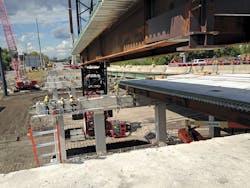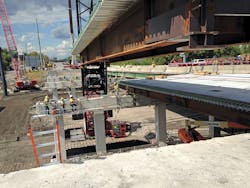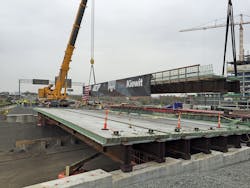Full speed ahead
In April 2015, the Tennessee Department of Transportation (TDOT) announced plans to replace part of its aging infrastructure on the outer loop of I-40 in downtown Nashville.
The project, better known as “Fast Fix 8,” included demolishing and reconstructing eight bridge decks over a 13-week period. With a 58-hour time frame for completion of each respective bridge, demolition began each weekend over that 13 weeks on Friday at 8 p.m. to be completed within 12 hours. The bridges were then constructed utilizing an accelerated bridge construction (ABC) method, allowing each bridge to be opened to traffic by 5 a.m. on the following Monday.
To expedite construction, much of the concrete decking was precast in sections on-site in the median of I-40. The panels were used on multiple bridge locations where they were relocated from the median to their respective locations and lifted into place. The mix employed for the panels was TDOT Class D 4,000-psi concrete. The schedule, however, called for midnight delivery at 70 yd per hour with a load size average of 6 cu yd. Placement of the panel concrete was completed each time before rush-hour traffic began.
The right mix
During a meeting in April 2015, Kiewit Infrastructure approached Irving Materials Inc. with a request to produce high early-strength concrete (4,000 psi in four hours). The purpose of the mix was to fill the voids which created the bond between the precast panels. The requested mix would be used in place of the bagged grout typically used in such a situation and required per the specifications. Kiewit needed a workable concrete mix capable of being produced consistently while achieving early strength. The ready-mix option would allow Kiewit to reduce both material and labor costs while maintaining the construction schedule.
The quality-control team quickly began developing options for the concrete mix based on the design specification, local raw materials and admixtures. Type III cement was necessary to achieve the high early strength. Due to minimal rebar spacing and the narrow dimensions of the placement areas, a nominal maximum coarse aggregate size of 3⁄8 in. was chosen. The coarse and fine aggregates were blended for optimal grading of a self-consolidating concrete mixture. The ultimate focus of the design, however, was the extensive selection of admixtures necessary to achieve early strengths while maintaining plastic properties, the contribution of each and effective dosages. The combination of admixtures required to balance each property of the mix dictated the design be self-consolidating. The greatest challenge was producing a mix capable of maintaining workability for greater than 45 minutes for travel and unloading while achieving design strength in four hours.
With material selections made, lab trials were initiated. During the testing, a concrete mix design curve based on cement content and water demand was developed. A general assessment of necessary admixture dosages also was achieved. With data generated from the initial round of trials, adjustments were made and more lab trials were performed—all of which assisted in preparing the design for field trials.
The results from the lab trials allowed the selection of a concrete design meeting the compressive strength parameters. Prior to batching at the ready-mix facility, considerations were made for admixture sequencing. The compilation of six admixtures had to be carefully considered when limited to an initial load size of 3 cu yd. Each admixture needed to be automatically dispensed and mixed without being exposed to the next admixture before entering the concrete.
The bridge panels on the Fast Fix 8 project were cast in the median, relocated to their respective locations and bonded with the TDOT Class X mix.
Getting real-world ready
Field testing began with 3-cu-yd test batches. With each trial batch, an initial check of plastic properties including concrete temperature, unit weight, air and slump were taken. The concrete was then maintained on the mixer at agitating speed for approximately 20 minutes to simulate transit. Once complete, the same testing sequence for plastic properties was repeated to include 6 x 12 cylinders for four-hour strength determination.
The transit simulation testing sequence created the opportunity to observe the variance in plastic properties, monitor consistency and the setting of the mix. All were critical properties in managing the batching, delivery and unloading processes. Concrete temperatures and the dosage of the hydration stabilizing admixture determined the allowable amount of time the concrete could remain on the truck before setting and strength was achieved. Finding the balance between providing an adequate time frame for unloading while not negatively affecting strengths was challenging and required additional trials.
In addition to compressive strength, the engineering specification required testing for chloride ion content, shrinkage, bond strength and freeze-thaw durability. Representatives from Middle Tennessee State University’s Concrete Industry Management program assisted in performing the additional testing. Throughout the development of the mix, communication was maintained with TDOT regarding materials and the mix properties. Based on those conversations, the quality-control team was able to assist in developing the site acceptance parameters for the concrete.
In order to gain an understanding of mix performance during placement, Kiewit built forms including rebar duplicating the dimensions of the project placement locations. Placing the mix in the forms gave the finisher an idea of the time available for finishing and the overall consistency for finishability. Over a period of eight weeks that saw over 20 field batches and 100 cylinders, the mix termed by Kiewit as “closure pour material” was ready for TDOT approval and project placement.
Due to the limited time frame of the placements, communication between the contractor and concrete producer was critical. From a technical side, control of the concrete variables associated with the mix was required before and during batching. The before-batching variables included but were not limited to aggregate moistures, admixture and ice dosages. During production, each load was checked for slump, air, unit weight and temperature at the ready-mix facility. With varying ambient temperatures and admixture dosages during each placement, air entrainment was the most difficult variable to control. Adjustments were made frequently to achieve design tolerances.
This project map highlights four of the bridge decks that underwent demolition and reconstruction on the Fast Fix 8 project.
American Concrete Institute certified technicians were located at the project to monitor site consistency and make sample specimens for compressive strength. The technicians communicated regarding the aforementioned plastic properties. Based on the results, minor adjustments were made primarily to the admixtures throughout the placement to maintain performance within the allowable limits of the specification. Making adjustments was critical considering the limited time frame to unload the concrete.
In addition to the capabilities of the mix, there was a learning curve involved in production and scheduling for all parties. The mix would begin to set in approximately 45 minutes from batching. This left a short window of opportunity for placement. The time allotted for batching and delivery was 15 minutes with an approximate 30-minute unloading time. The initial plan involved batching 3-cu-yd loads to be placed with a crane and bucket by a 15-craft crew. Over time, as confidence grew in the mix and with Kiewit’s introduction of the conveyor for placement, the process for unloading the mixers was reduced. The load size was incrementally increased to a maximum delivered quantity of 6 cu yd. Maintenance for the concrete production team included jack-hammering crews on-site after two consecutive placements. Both the central mixer and truck drums required chipping due to the detrimental effect of the fast-setting mix on the equipment.
Throughout the duration of all placements, both bridge panels and closure pour material, communication between the contractor and concrete producer’s team was critical to meeting the project specification that required traffic to be opened to the public by 5 a.m. Monday morning. This time target was achieved on all placements.
In December 2015, seven months ahead of schedule, TDOT announced the completion of the project. The key to the success was a carefully planned construction schedule and building materials delivered on time and to specification.



